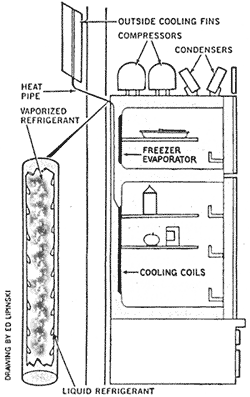 Cold
Weather Passive Assist Refrigeration Cold
Weather Passive Assist Refrigeration
If you live in a cold climate,
your refrigerator is often running when the temperature outside is colder
than it is in your refrigerator. A simple way of using the “coolth”
from the outside to cool your refrigerator is by incorporating a heat
pipe. A heat pipe is a passive device that transfers heat by evaporation
and condensation. Steam heat and steam cooking vegetables are examples
of heat pipes in use. Absorbed heat boils water, the steam then condenses
and releases its heat while heating your house or cooking your food, the
condensed water then drains back to the boiler.
A heat pipe can be used to transfer
heat from a refrigerator compartment to the outside. When the temperature
is colder outside than in the refrigerator, the liquid in the refrigerator
boils, absorbing heat and cooling the refrigerator compartment. The refrigerant
then condenses outside and runs back to the refrigerator (see diagram).
The pressure in the tube changes with temperature, so the liquid always
boils when the temperature is colder outside than in the refrigerator.
This device acts as a one-way thermal valve, if the temperature is hotter
outside than in the refrigerator heat is not transferred into the refrigerator.
Refrigerators we manufactured
incorporating a heat pipe also contain an active cooling system. When
the temperature outside warms and the refrigerator can no longer be passively
cooled, a thermostat with a preset temperature will turn on the compressor
and cool the refrigerator compartment. Installation required only drilling
a _ inch hole for the heat pipe running from the refrigerator to the outside.
In the mid 1980’s we built
about ten of these hybrid refrigerators. The models without a freezer
compartment coupled very effectively with a solar system. Since during
the winter when available sunlight is limited, the refrigerator is passively
cooled and requires no energy to run. With our RF16, the freezer compartment
consumes about 60% of the total energy consumed by the unit. During the
winter, the heat pipe would decrease energy use by 40%. One of the passively
cooled refrigerators is located at the Rocky Mountain Institute in Colorado,
where winters are long and passive cooling is effective. Although these
refrigerators operate effectively, sales were limited and we no longer
manufacture that model.
<<
Back to Concepts for Sustainable Living
|

